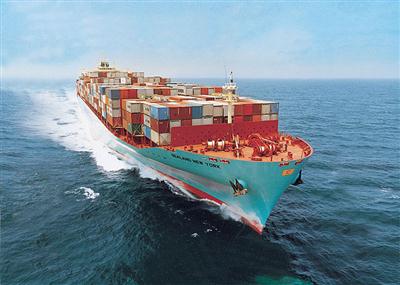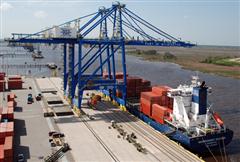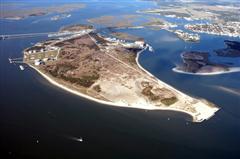SOUTHPORT — Staying competitive in the maritime import and export business will cost billions in transportation improvements and construction at North Carolina’s ports, a state study suggests.
The N.C. Maritime Strategy final report calls for intricate roadway and rail additions throughout the state, more facilities in and near the ports of Morehead City and Wilmington, and dredging projects to make way for massive sea vessels known as super post-panamax ships, which will be able to travel through the Panama Canal once it is widened by 2014.
Supporter Spotlight
 Post pana-max ship Photo credit: U.S. Department of Transportation |
It’s a multi-billion, multi-year ports project proponents say will be an economic boon for the state, one that will create jobs and give North Carolina a legs-up against other East Coast ports vying for maritime business.
But for others, those living in the small, coastal communities pinpointed in the study, the more than 200-page report paints an alarming picture of grandiose ideas that are too big, too expensive and ultimately a threat to the state’s natural coastal habitat.
Among the major concerns residents, business owners and environmentalists expressed during a series of public meetings the state held before releasing the final report – air and water quality impacts, truck traffic, and adverse affects created by dredging.
More than 300 signatures for “Support the Port” and “Future Development Port of Morehead City” were turned over to the state. A petition opposing port development in Southport, a town nestled on the lower Cape Fear River opening into the Atlantic Ocean, garnered more than 700 signatures.
Mike Rice, the man behind Save the Cape, Inc., a nonprofit group that seeks to preserve the lower Cape Fear River, has for the past few years been part of the fight against the proposed N.C. International Terminal, a mega-port that would be built on 600 acres near his Southport home.
Supporter Spotlight
 Containers at the Port of Wilmington Photo credit: N.C. Ports Authority Containers at the Port of Wilmington Photo credit: N.C. Ports Authority |
Speculation that plans for the mega-port have died because of lack of support has gained traction during the past several months. Good news, Rice said, but not assurance that Southport will not see port development in the future.
The maritime strategy report suggests the state’s future container needs could be met by expanding the Port of Wilmington terminal or building a new greenfield container port at one of three locations: River Road in Wilmington, Southport or Radio Island in Morehead City.
In order to expand container sites at the Port of Wilmington, the state would need to deepen more than 20 miles of the Cape Fear River that stretches from the port to the Atlantic Ocean.
Construction of a container port in Southport would require a turning basin to accommodate post-panamax ships, a new access channel from the main channel and dredging.
“Establishing this site would mean industrialization of an area that, because of the massive scale they have in mind, it would just change the character of Southport,” Rice said.
Such a facility would require more roadways since the nearest four-lane highway is 17 miles away. The railroad nearest the proposed site is owned by the U.S. Department of Defense and serves Military Ocean Terminal Sunny Point, the nation’s largest munitions terminal.
The proposed Southport container site is not only close to the terminal, it’s near the Brunswick County Nuclear Plant, which is cooled by water from the Cape Fear River.
“That can’t be interrupted in any way,” Rice said. “It’s an awkward, difficult site. We don’t want this around here. It’s trying to counteract geography. We’re terrified of the effects, from air pollution to dredging, it would have here.”
Similar sentiments are shared among Beaufort residents who fear the wrong kind of port-related construction on Radio Island would hurt, not help that area.
Beaufort resident Nelson Owens began to understand what he believes will be negative economic and environmental impacts in the area if DOT moves forward with plans to build a fixed-span bridge across Gallants Channel to replace the current drawbridge. The Southern Law Environmental Law Center says that construction of the proposed bridge is a segment of the Super 70 corridor linking Raleigh to Morehead City, tying directly into future port operations, a claim N.C. DOT denies.
Owens served on a committee that studied the potential economic impacts of the Gallants Channel bridge, a proposed 65-foot-high fixed-span bridge. He and other opponents of the bridge say the design and location of the bridge would have significant impacts on the local economy and maritime safety. The state Department of Commerce agrees, citing that a fixed-span bridge will, “negatively impact current and future business operations.”
“It’s definitely not going to be a good impact for Beaufort because of the way it affects the property and the town of Beaufort,” Owens said.
The bridge would change the face of Beaufort, which would see freight hauled to and from the port with little economic benefit, Owens argues.
The maritime strategy study includes plans for a dry sulfur-handling facility at the Port of Morehead City as well as a potential container port on Radio Island. If the state develops a container port there, the existing berth area would have to be dredged and a larger turning basin would need to be created to accommodate post-panamax vessels.
Owens said he does not support port development on Radio Island because of its proximity to surrounding natural, protected habitats such as the Rachel Carson Reserve, Shackelford Island, Cape Lookout National Seashore and Fort Macon State Park.
“I don’t understand,” Owens said. “All these states expending and spending billions of dollars on the ports and all this business might not be there.”
Doug Doubleday, a Beaufort resident also opposed to the proposed fixed-span bridge over Gallants Channel, said he is concerned about the dredging proposed in the maritime study.
 Aerial photo of Radio Island Photo credit: N.C. Ports Authority |
Beaches have actually benefited from port-related dredging projects, where quality sand has been pumped onto eroded shorelines beaten by storms.
But dredging to the scale discussed in the maritime report may cause erosion along area beaches, Doubleday said.
Still, he is not opposed to expansion at the Port of Morehead City.
“Development on Radio Island – I’d rather see tourism-related things developed there,” he said. “But, the port does own some land there. If they develop responsibly, it shouldn’t be a problem. I just want them to be very, very sensitive and careful with the environment.”







